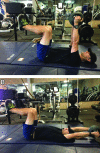Treatment of nonspecific thoracic spine pain with trigger point dry needling and intramuscular electrical stimulation: a case series
- PMID: 25328832
- PMCID: PMC4196334
Treatment of nonspecific thoracic spine pain with trigger point dry needling and intramuscular electrical stimulation: a case series
Abstract
Study design: Case Series.
Background and purpose: Myofascial trigger points (MTrPs) are a common occurrence in many musculoskeletal issues and have been shown to be prevalent in both subjects with nonspecific low back pain and whiplash associated disorder. Trigger point dry needling (DN) has been shown to reduce pain and improve function in areas such as the cervical and lumbar spine, shoulder, hip, and knee, but has not been investigated in the thoracic spine. The purpose of this case series was to document the use of DN with intramuscular electrical stimulation (IES) in subjects with nonspecific thoracic spine pain.
Case description: The subjects were both active duty military males aged 31 and 27 years who self-referred to physical therapy for thoracic spinal pain. Physical examination demonstrated thoracic motor control dysfunction, tissue hypertonicity, and tenderness to palpation of bilateral thoracic paraspinal musculature in both subjects. This indicated the presence of possible MrTPs. Objective findings in the first subject included painful thoracic flexion and bilateral rotation in each of these planes of movement. Pain reduction was observed when postural demands of the spine and trunk musculature were reduced through positional changes. Patient 1 demonstrated pain with posterior to anterior (P/A) pressure at T9 to T12. The second subject had bilaterally limited and painful thoracic rotation actively with normal passive rotation and demonstrated pain with P/A pressure at T4 to T7.
Intervention: The subjects were treated with DN and IES for a total of two visits each. DN was performed to paraspinal and multifidus musculature at the levels of elicited pain with P/A testing and IES set at a frequency level of 4 (1.5Hz) for 20 minutes.
Outcomes: Subject 1 reported reduced pain with standing flexion from a 62mm VAS score on initial evaluation to 26mm at his second visit. Subject 2 reported being "quite a bit better" in symptoms on the GROC following his second treatment. His VAS score reported following weightlifting activities changed from 43mm on initial evaluation to 20mm at his second visit. Both subjects also demonstrated a 10 degree improvement in active thoracic spinal rotation (on the right for Subject 1 and bilateral for Subject 2) following their second treatment.
Discussion: Both subjects demonstrated motor control dysfunctions and pain with P/A pressure in the thoracic spine. With the use of DN and IES, immediate reduction was seen in subject perceived symptoms, and pain free ROM was improved. Extended treatment and follow up was not plausible due to the high pace tempo and demands of their operational training schedule. With research indicating the influence of MTrPs on a multitude of musculoskeletal issues and the prevalence of thoracic spine pain, further research is indicated for examining the effects of DN and IES for motor control and painful conditions occurring in the thoracic spine.
Level of evidence: Level 4.
Keywords: Dry needling; intramuscular electrical stimulation; myofasical trigger points; thoracic spine pain.
Figures










Similar articles
-
The use of trigger point dry needling and intramuscular electrical stimulation for a subject with chronic low back pain: a case report.Int J Sports Phys Ther. 2013 Apr;8(2):145-61. Int J Sports Phys Ther. 2013. PMID: 23593553 Free PMC article.
-
Treatment of thoracic spine pain and pseudovisceral symptoms with dry needling and manual therapy in a 78-year-old female: A case report.Physiother Theory Pract. 2022 Nov;38(13):3255-3263. doi: 10.1080/09593985.2021.1987603. Epub 2021 Oct 10. Physiother Theory Pract. 2022. PMID: 34632909
-
The use of dry needling for a subject with acute onset of neck pain: a case report.Int J Sports Phys Ther. 2015 Feb;10(1):104-13. Int J Sports Phys Ther. 2015. PMID: 25709869 Free PMC article.
-
Effectiveness of Dry Needling of Myofascial Trigger Points in the Triceps Surae Muscles: Systematic Review.Healthcare (Basel). 2022 Sep 24;10(10):1862. doi: 10.3390/healthcare10101862. Healthcare (Basel). 2022. PMID: 36292308 Free PMC article. Review.
-
The use of dry needling as a diagnostic tool and clinical treatment for cervicogenic dizziness: a narrative review & case series.J Bodyw Mov Ther. 2018 Oct;22(4):947-955. doi: 10.1016/j.jbmt.2018.02.015. Epub 2018 Feb 17. J Bodyw Mov Ther. 2018. PMID: 30368340 Review.
Cited by
-
Intramuscular Electrical Stimulation Combined with Therapeutic Exercises in Patients with Shoulder Adhesive Capsulitis: A Randomised Controlled Trial.Int J Surg Protoc. 2021 May 18;25(1):71-83. doi: 10.29337/ijsp.25. Int J Surg Protoc. 2021. PMID: 34056148 Free PMC article.
-
Short-Term Effects of PENS versus Dry Needling in Subjects with Unilateral Mechanical Neck Pain and Active Myofascial Trigger Points in Levator Scapulae Muscle: A Randomized Controlled Trial.J Clin Med. 2020 Jun 1;9(6):1665. doi: 10.3390/jcm9061665. J Clin Med. 2020. PMID: 32492884 Free PMC article.
-
Dry needling for the management of thoracic spine pain.J Man Manip Ther. 2015 Jul;23(3):147-53. doi: 10.1179/2042618615Y.0000000001. J Man Manip Ther. 2015. PMID: 26309385 Free PMC article.
-
A comparative study of sonographic and clinical parameters in patient with upper trapezius muscle trigger point following dry needling and intramuscular electrical stimulation: a randomized control trial.Chiropr Man Therap. 2025 Apr 14;33(1):14. doi: 10.1186/s12998-024-00567-8. Chiropr Man Therap. 2025. PMID: 40229803 Free PMC article. Clinical Trial.
-
Effects of Intramuscular Electrical Stimulation Using Inversely Placed Electrodes on Myofascial Pain Syndrome in the Shoulder: A Case Series.Korean J Pain. 2016 Apr;29(2):136-40. doi: 10.3344/kjp.2016.29.2.136. Epub 2016 Apr 1. Korean J Pain. 2016. PMID: 27103970 Free PMC article.
References
-
- Briggs AM Bragge P Smith AJ Gouil D Straker LM Prevelence and associated factors for thoracic spine pain in the adult working population: a literature review. J Occup Health. 2009;51: 177‐192 - PubMed
-
- Wood KB Garvey TA Gundry C Heithoff KB Magnetic resonance imaging of the thoracic spine. Evaluation of asymptomatic individuals. J Bone Joint Surg Am. 1995;77(11):1631‐1638 - PubMed
LinkOut - more resources
Full Text Sources
Medical
Research Materials
